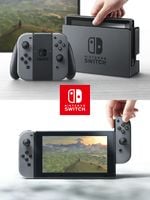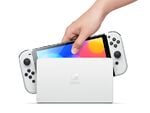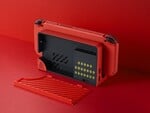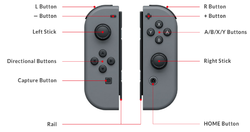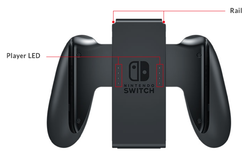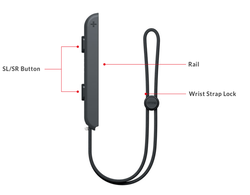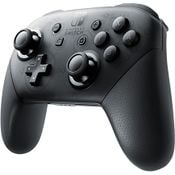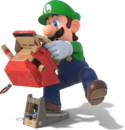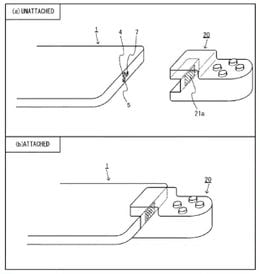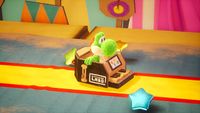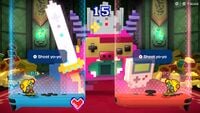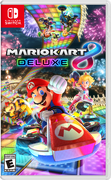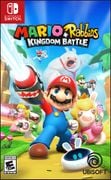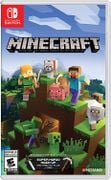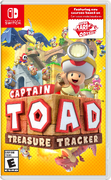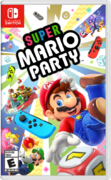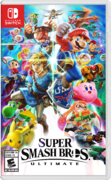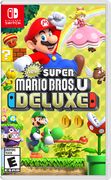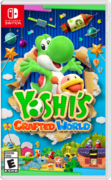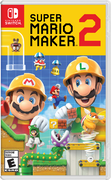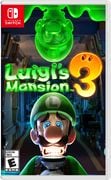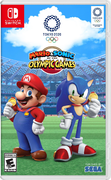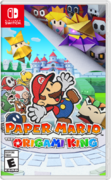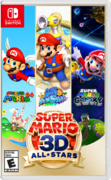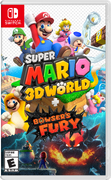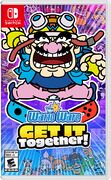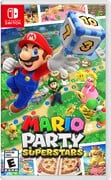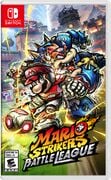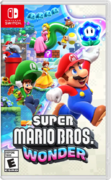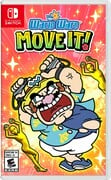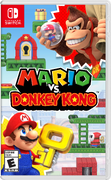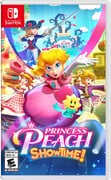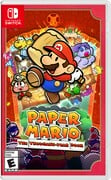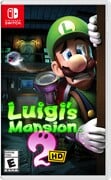Nintendo Switch
| Nintendo Switch | |
|---|---|
 TV mode  Tabletop mode 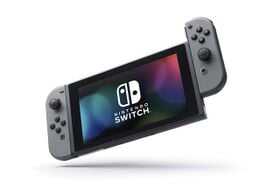 Handheld mode | |
| Generation | Eighth generation |
| Release date | Nintendo Switch: Template:Release Nintendo Switch Lite: |
| Discontinued | HAC-001 August 2019 HAC-001(-01) N/A HDH-001 N/A HEG-001 N/A [?] |
| Predecessor | Wii U |
| Successor | N/A |
- “Switch and Play”
- —Advertisement slogan for the Nintendo Switch
The Nintendo Switch, or simply the Switch, is a hybrid video game console released by Nintendo and its seventh major home game console as the successor to the Wii U. The system is both a home console and a handheld console.[1] During development, the console was codenamed "NX."[2] It was officially announced on October 20, 2016,[3] and was released simultaneously on March 3, 2017, in Japan, America, Europe, Hong Kong, and other territories.[4] It costs US $299.99 in America and JP ¥29,980 in Japan.[4] A Nintendo Switch presentation containing more information about the system was live-streamed from January 12, 2017, at 11:00 PM to January 13, 2017, at 12:05 AM EST.[5][4] The Nintendo Switch had a hands-on event on six separate Sundays in six different cities across America prior to its release date,[4] along with Tokyo Big Sight, Japan.[4] Preorder retail reservations started on January 21, 2017, in Japan.[4]
On January 4, 2018, Nintendo announced that the Nintendo Switch had sold over 10 million units and became the fastest-selling video game console in America within a time frame of the first ten months.[6] As of December 31, 2021, the Nintendo Switch family sold 103.54 million units worldwide, making it surpass the Wii to become Nintendo's highest-selling home console.[7] As of March 31, 2023, it sold 125.62 million units worldwide with over one billion units of software sales,[8] ranking it as the third-highest-selling video game console of all time, behind the Nintendo DS and PlayStation 2.[9] In February 2024, the Nintendo Switch surpassed the Nintendo DS as the highest-selling video game system in Nintendo's native Japan.[10] The Nintendo Switch is often credited with bringing Nintendo back to financial relevance following the Wii U's disappointing sales.[11]
Features
The Nintendo Switch is an LCD tablet-like console that is designed to be a hybrid between home and handheld systems. The Nintendo Switch can be played in three different styles: TV mode, Tabletop mode, and Handheld mode.[4] In TV mode, the system is plugged into a "Nintendo Switch Dock."[12] With the system docked, gameplay footage is displayed on the TV screen. With the console detached, the footage is displayed on the console's screen. When a player uses Tabletop mode, the console uses a built-in kickstand to prop the system up. When the console is in Handheld mode, the two "Joy-Con" controller pods are attached to the sides of the console, giving it a similar design to the Wii U's GamePad. The Joy-Con can also be removed and used as separate controllers, similar to small NES and SNES controllers; used as one controller together; or optionally docked into the "Joy-Con Grip"[12] to give a more traditional experience.
The Nintendo Switch console uses "Game Card" cartridges, similar to the Nintendo DS line. The Nintendo Switch Dock also has two USB 2.0 ports, an HDMI output,[4] an AC adapter port, and a TV output LED light. The Nintendo Switch has built in Wi-Fi,[4] Bluetooth 4.1 connectivity, a multi-touch capacitive touchscreen of 6.2-inch diagonally,[4] a resolution of 1080p on TV mode and 720p on Tabletop and Handheld modes, a USB Type-C connector,[4] internal storage of 32 GB, a microSD slot (which also supports microSDHC/SDXC cards up to 2 TB; ejecting the card during use will forcibly turn off the Switch), a 3.5mm headphone jack, a brightness sensor, two speakers in the bottom, and a battery life ranging anywhere between 2.5–6.5 hours.[4] For example, battery life during The Legend of Zelda: Breath of the Wild gameplay is three hours.[13]
Players can also link up to eight multiple consoles to play against each other via local multiplayer.[4] Each Joy-Con can be used for two-player co-op, dubbed by Nintendo as "sharing the joy."[4]
Due to being both a home console and a handheld console, the Nintendo Switch is the first one-screen dedicated handheld since the Game Boy Micro in 2005.
Language and region support
The Nintendo Switch does not have region locking (except the mainland China model),[14] similar to Nintendo handhelds prior to the Nintendo DSi, and features enhanced language and region accessibility. The system can be changed to any of the nine languages: English, French, German, Spanish, Italian, Dutch, Portuguese, Russian, and Japanese. As of January 29, 2019, it can also be changed to Traditional Chinese, Simplified Chinese, and Korean.[15]
There are four different region codes that the user can select from: Japan, the Americas, Europe, and Australia/New Zealand.[16] As of April 15, 2019, it can also be changed to Hong Kong/Taiwan/South Korea. Depending on the region code chosen, the dialect for the English, French, and Spanish languages will also change (e.g., setting the region code to Europe and the language to English sets the overall language to British English, while setting the region code to The Americas and the language to English sets the overall language to American English). As of December 1, 2020, setting the region code to The Americas and the language to Portuguese sets the overall language to Brazilian Portuguese.[17]
The mainland China (Tencent) model is region-locked, and users cannot change their region (China) or language (Simplified Chinese). It plays import cartridges, but it does not support online multiplayer on import games or non-China eShop access. China-region cartridges cannot be played on other Nintendo Switch models.[14]
Hardware revisions
Nintendo Switch Lite
The Nintendo Switch Lite (model number HDH-001) is the second version of the Nintendo Switch, announced on July 10, 2019 and released worldwide on September 20, 2019. Unlike the original, this console is smaller and is handheld only, lacking the ability to be docked. This console can only play games that support Handheld mode. Games that require use of motion controls (e.g. Super Mario Party) are not supported due to absence of the IR Motion Camera (though regular Joy-Con controllers can be connected to play these games). The directional buttons are also replaced by a single directional pad. Due to only being able to play in Handheld mode, the Nintendo Switch Lite can only render games at a maximum output resolution of 720p.
Extended battery revision
On July 17, 2019, Nintendo announced a slightly enhanced version of the Nintendo Switch with the model number HAC-001(-01), which is identical to the original in appearance but sports substantially longer battery life; whereas an original Nintendo Switch has only 2.5 to 6.5 hours of battery life, this version has 4.5 to 9 hours of battery life. It was first released on August 13, 2019.[18] Like its original revision, this extended battery revision is both a home console and a handheld console.[1]
Nintendo Switch – OLED Model
The Nintendo Switch – OLED Model (model number HEG-001) is an enhanced revision of the Nintendo Switch that was announced on July 6, 2021, and features a 7-inch OLED screen, a wider and adjustable stand, enhanced audio, a wired LAN port built into the dock, and 64 GB of internal storage. The Joy-Con Grip included also has the logo engraved rather than being printed. It was released on October 8, 2021, and is available in white and neon blue/neon red.[19] Like the original model and its extended battery revision, the Nintendo Switch – OLED Model is both a home console and a handheld console.[20]
In the Super Mario Bros. Wonder Direct on August 31, 2023, Nintendo revealed a Mario Red Edition of the OLED Model, which features a silhouette of Mario printed on the bottom left on the back of the dock, and coins printed on the port station behind the dock's back cover. It was released on October 6, 2023.[21]
Peripherals
Joy-Con
The two Joy-Con have an accelerometer and gyro sensor.[4] The Joy-Con (R) has an IR motion camera that can sense and measure the real-time shape, motion, and distance of objects.[4] Two and
shoulder buttons are on each Joy-Con,[4] which can be only be pressed while the Joy-Con are not connected to anything other than straps. The Joy-Con can be slid into the Joy-Con Grip on the controllers' rails.[4] The Joy-Con launched with two color sets: the standard gray, along with neon blue and neon red.[4] Neon yellow Joy-Con were released on June 16, 2017, and neon pink and neon green Joy-Con were released on January 5, 2018.[22] Much like the Wii Remote, each Joy-Con has gray, detachable wrist straps with slide locks,[4] with other wrist strap colors sold separately.[4] Neon purple and neon orange Joy-Con were released on October 4, 2019.[23] Aside from just neon colors and gray, Joy-Con are available in standard blue, Mario-themed red, and Luigi-themed green colors.[23]
An "HD Rumble" feature for high definition haptic feedback is included in the Joy-Con, which can convey realistic effects. For example, a demo for the January 2017 presentation showed that shaking the Joy-Con can give the illusion of ice cubes being shaken within a glass cup.[4] The HD Rumble also helps move certain Nintendo Labo Toy-Con cardboard builds, such as a race car acting much like a toy remote controlled car when connected to the Joy-Con. The minigame-based game 1-2-Switch, which was released as a launch title, and the wrestling game ARMS, released on June 16, 2017, are two games that heavily utilize the Joy-Con HD Rumble and motion control features.[4]
The Joy-Con (L) has a capture button that can take a screenshot of gameplay, which can be saved onto the system's Album, and can later be edited and uploaded to social media. A Nintendo Switch 4.0.0 update on October 19, 2017 added the capacity to record real-time gameplay of up to 30 seconds and allow that to also be uploaded to social media, though it has been discussed that another update in the near future will allow for longer recording times.[4] The Joy-Con (R) contains a built-in camera for taking pictures and recording video. Both Joy-Con have Bluetooth 3.0 connectivity, and each has a charging time of 3.5 hours and a battery life of up to 20 hours.[24]
Buttons
- Release buttons
- Sync buttons
- Volume buttons
- Power
Nintendo Switch Pro Controller
A traditional controller, known as the Nintendo Switch Pro Controller,[12] has a traditional D-pad replacing the directional buttons on the Joy-Con (L). The Pro Controller features the same set-up as the Nintendo GameCube Controller, with the Right Stick set below the face buttons. The Nintendo Switch Pro Controller has a charging time of 6 hours and a battery life of up to 40 hours,[24] includes an NFC touchpoint for reading and writing amiibo figures and amiibo cards, and is sold separately.[4]
The phrase "THX2 ALLGAMEFANS!" can be found written on the Pro Controller's motherboard, just above ; the message is viewable by holding down
and peering through the transparent plastic in the surrounding socket.[25]
amiibo
- Main article: amiibo
The Nintendo Switch has amiibo support.[26] The Joy-Con (R), Nintendo Switch Pro Controller, and Nintendo Switch Lite, all have an NFC touchpoint for reading and writing amiibo figures and amiibo cards.[4][27]
Nintendo Labo
Nintendo Labo is a do-it-yourself cardboard toy platform for the Nintendo Switch, primarily targeted at children.[28] Players insert the Nintendo Switch console and Joy-Con in cardboard constructions (collectively referred to as "Toy-Con"), which are compatible with certain games.[29] First shown in January 2018, the Toy-Con themselves were released on April 20, 2018 as either a variety kit for US $69.99[30] or a stand alone robot suit for US $59.99[31]. The customization set for Nintendo Labo includes stickers of eyes of various Nintendo characters, including, but not limited to, Mario, Peach, Goomba, Boo, and Bowser.
As of the version 1.5.0 update on June 26, 2018, Mario Kart 8 Deluxe can be played with the Toy-Con Motorbike.[32] Mario Kart 8 Deluxe can also be played with the Toy-Con Car, Pedal, and Key as of the game's version 1.7.0 update.
Through the version 1.3.0 update, Super Mario Odyssey includes a VR experience of the game which uses the Nintendo Labo Toy-Con VR Goggles. The experience features three mini-missions set in the Cap Kingdom, Seaside Kingdom, and Luncheon Kingdom.[33]
In Super Smash Bros. Ultimate in versions 3.1.0 and later, a single player can play or spectate regular Time matches in virtual reality using the Toy-Con VR Goggles.[34]
The Nintendo Switch version of Captain Toad: Treasure Tracker became compatible with the Toy-Con VR Goggles through the version 1.3.0 update, which features a mode where the player can play VR versions of four of the game's levels: Episode 1 Prologue, Walleye Tumble Temple, Briny Bowl Swimming Hole, and Mine Cart Tunnel Throwdown.[35]
GameCube Controller Adapter
As of version 4.0.0, the GameCube Controller Adapter originally developed for the Wii U can also be used for compatible games on the Nintendo Switch such as Super Smash Bros. Ultimate, allowing the user to connect up to four Nintendo GameCube Controllers. Like on the Wii U, there are two USB ports on the Switch dock into which the adapter is plugged.
All games recognize the GameCube controllers as a wired Nintendo Switch Pro Controller without motion controls, with the exceptions of Super Smash Bros. Ultimate and the Super Mario Sunshine remaster in Super Mario 3D All-Stars (as of the version 1.1.0 update), both of which have native GameCube Controller support. The control stick (![]() ), the
), the ![]() stick, and the
stick, and the ![]() and
and ![]() buttons are treated as the
buttons are treated as the and
sticks and the
and
buttons, respectively, making the GameCube Controller have slightly limited controls compared to the Nintendo Switch Pro Controller in some games due to the lack of
and
buttons (as well as the button functionality of
and
, to a lesser extent). The player also cannot return to the home menu, take screenshots, or use the amiibo functionality, due to the lack of
and
buttons and an NFC touchpoint, respectively.
Software
Software for Nintendo Switch can be purchased from retail and/or Nintendo eShop (in addition, some software can be downloaded from eShop for free). The Nintendo Switch is the first major home console since the Nintendo 64 to have retail software stored on cartridges rather than discs.
Nintendo Switch Online
- Main article: Nintendo Switch Online
Nintendo Switch Online is a subscription service that grants players online play for compatible Nintendo Switch games, which launched on September 18, 2018 in North America,[36] and on September 19, 2018 in Japan, Europe, and Oceania.[37][38][39] Prior to its launch, players were able to play online at no charge during a "free trial" period, after which they must pay a subscription fee for a plan lasting in increments of one month, three months, or 12 months. A week long trial period is available to use, after which payment will automatically begin renewing for the specified plan unless auto-renewal is turned off. The Nintendo Switch is also able to synchronize with smartphones via an application of the same name; this allows for online capability to invite friends to play online, set play appointments, and voice chat with friends on online matches.[4] Subscribers can also find Nintendo Switch Online-specific news and information in an application of the same name on the Switch's home menu. Standard online features such as the Nintendo eShop and system updates do not require a Nintendo Switch Online subscription to access.
Nintendo Switch Parental Controls
The Nintendo Switch also uses optional parental controls, being controlled from a smartphone via an application named Nintendo Switch Parental Controls, in order to control and monitor a minor's playing time, as well as restricting certain features of the Nintendo Switch. Nintendo has released a video featuring Bowser and Bowser Jr. detailing the functions of the application in multiple languages, with the former monitoring the latter's playing of Mario Kart 8 Deluxe.
Nintendo eShop
- Main article: Nintendo eShop
The Nintendo eShop is the online storefront used for purchasing software and games on the Nintendo Switch. It was revealed during a small footage depicting the Nintendo Switch's system menu, which is available after a system update.[4]
Nintendo Switch HOME Menu
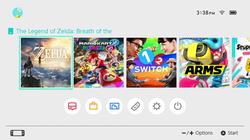
At the top of the Nintendo Switch's system menu, referred to as the HOME Menu,[40] there are profile icon(s), a time display, a Wi-Fi/airplane mode status display, and a battery display. The middle portion includes grids for displaying games' icons, and the bottom has icons for applets including Nintendo Switch Online, News, Nintendo eShop, Album, Controllers, System Settings, and Sleep Mode, along with a controller display in the lower left.[4]
Development
Internal documents leaked in 2020 show that the Nintendo Switch originally started life as a successor to the Nintendo 3DS. Codenamed "Project INDY" and co-developed with ST Microelectronics, this rendition would've been a more powerful version of the 3DS, retaining stereoscopic 3D support and a secondary touch screen while also incorporating new features such as Bluetooth and videotelephony support. Project INDY also featured the ability to wirelessly project game footage to a TV screen using the Miracast standard, acting as an early precursor to the Switch's hybrid model. In late 2014, Nintendo ended their partnership with ST Microelectronics, by which point the Switch's name had been finalized; its design at this point was revised to a single touchscreen like that seen in the final product.[41]
While Nintendo had settled on its final name by 2014, the Nintendo Switch was codenamed the "NX" during development following their split from ST Microelectronics; the codename was not believed to have meant anything in particular.[42] The development of the NX was first mentioned by Satoru Iwata on March 15, 2015 during Nintendo and DeNA's Business and Capital Alliance Announcement, where it was discussed how Nintendo was aiming to "construct a bridge between smart devices and dedicated video game hardware".[2] Later that year, the new Nintendo president Tatsumi Kimishima elaborated by saying that the NX was not going to be another version of the Wii or Wii U platforms, rather "something unique and different".[42]
In 2013, Nintendo chose to merge the handheld and home console development teams into a single Research & Development division,[43] due to the emerging possibility of integrating the software used by both platforms. Satoru Iwata said that it was important to "take advantage" of the established architecture of the Wii U while developing a future system, because of the ability to use common ways to program a handheld display and a full-size television display. At the time, Iwata stated that Nintendo was aiming to change the situation of developing separate versions of games for both handheld and console versions. He expressed interest in developing new hardware using the common programming of Android software, which would help alleviate the time taken to port the same game between separate handheld and home console releases.[43]
Yoshiaki Koizumi, the general producer of the Nintendo Switch console, made sure that the hardware development team included experience from "various different sections and disciplines", including both handheld and home console design.[44] He wanted to make sure that there was a high potential of "mixing and matching" those different areas of experience, to reach a single product. Many different hardware designs were proposed and considered, including a patented elliptical touch-screen controller capable of 3D display,[45][44] as well as a controller which uses a camera to sense the player's hand actions.[44] The NX's vision was to appeal to the on-the-go lifestyle of today's consumers, and adapt to their needs. This lead to the concept of "switching" between a home console and a handheld. However, during an interview with The Wall Street Journal, Reggie Fils-Aimé primarily referred the NX to mostly as a home console that can be played on the go, aside from being just a dedicated portable handheld system,[46] until the Nintendo Switch was eventually revealed on October 20, 2016 as both a home console and a handheld console.[3][1]
Shinya Takahashi, the general manager of the Entertainment Planning & Development Division at Nintendo, described how the early brainstorming stages focused on the essential functions of a portable home console.[44] The team also looked back at the accessibility and popularity of the Wii when developing the Switch, while still retaining features from other past Nintendo consoles, such as the handheld screen of the Wii U. Early on, it was also considered important for the system to come with two controllers that can be attached and brought on the go for two players to easily play together (in a similar way to how the Famicom docked two controllers on the system), although still providing a "full and satisfying single-player experience". Reggie Fils-Aime stressed the concept of "constant engagement" during Nintendo Switch planning, and appeal to an "anywhere, anytime, any way" approach.[47] The use of color was recognized to have been emphasized by Nintendo's systems in the past, notably with the Nintendo GameCube and Super Nintendo's multi-colored buttons. This inspired the use of red and blue Joy-Con for the Nintendo Switch, whereas the alternative gray design was aimed to appeal more to a "core gamer who is looking for something more sleek".[44]
A notable challenge during development was "packing" all of the required technology and features into the Joy-Con's desired weight and size, such as the IR Motion Camera, while still focusing on "communicating" the value of that technology through the software.[44] The HD Rumble, described by Yoshiaki Koizumi as a form of "virtual reality", required a lot of collaboration and trials between the hardware and software teams in order to utilize it within game design.
In 2015, Satoru Iwata spoke about how the need for region locking was not entirely due to consumer actions, but of the seller in global vendor licenses and different circumstances between countries. Iwata acknowledged that there were advantages for both the consumers and Nintendo in lifting region restrictions, and if future hardware were to use region-free games, then such problems would need to be pre-determined and subsequently solved.[48] On January 12, 2017, Nintendo announced during a livestream presentation that the Nintendo Switch's games will be region-free.[49]
The name "Nintendo Switch" was decided due to the ability to easily switch from a television screen to a handheld screen, as well as being akin to flipping a switch to "change the way people experience entertainment in their daily lives."[50]
Physical and digital games
2017
- Mario Kart 8 Deluxe
- Mario + Rabbids Kingdom Battle (Gold Edition, featuring Season Pass content, later released separately)
- Super Mario Odyssey
2018
- Donkey Kong Country: Tropical Freeze
- Minecraft: Bedrock Edition
- Mario Tennis Aces
- Captain Toad: Treasure Tracker
- Super Mario Party
- Super Smash Bros. Ultimate
2019
- New Super Mario Bros. U Deluxe
- Yoshi's Crafted World
- Super Mario Maker 2
- Luigi's Mansion 3
- Mario & Sonic at the Olympic Games Tokyo 2020
2020
2021
- Super Mario 3D World + Bowser's Fury
- Mario Golf: Super Rush
- WarioWare: Get It Together!
- Mario Party Superstars
2022
2023
2024
- Mario vs. Donkey Kong
- Princess Peach: Showtime!
- Paper Mario: The Thousand-Year Door
- Luigi's Mansion 2 HD
- Nintendo World Championships: NES Edition
Nintendo eShop exclusive games
- Minecraft: Nintendo Switch Edition
- Arcade Archives: Mario Bros.
- Arcade Archives: VS. Super Mario Bros.
- Arcade Archives: Donkey Kong
- Nintendo Entertainment System - Nintendo Switch Online
- Arcade Archives: Donkey Kong Jr.
- Arcade Archives: Donkey Kong 3
- Mario Tennis Aces: Online Tournament Demo
- Mario Tennis Aces: Special Online Demo
- Arcade Archives: Pinball
- Super Nintendo Entertainment System - Nintendo Switch Online
- Arcade Archives: VS. Golf
- Arcade Archives: VS. Wrecking Crew
- Super Mario Bros. 35
- Mario Kart Live: Home Circuit
- Nintendo 64 - Nintendo Switch Online
- Game Boy - Nintendo Switch Online
- Game Boy Advance - Nintendo Switch Online
Appearances in the Super Mario franchise
The Nintendo Switch console and its peripherals have made multiple appearances in the Super Mario franchise.
Super Mario Run
A docked Nintendo Switch with red and blue Joy-Con attached appears as a statue in Super Mario Run's Kingdom Builder mode. Tapping it shows the console being removed from the dock which the screen displays the key artwork from Mario Kart 8 Deluxe.
Donkey Kong Country: Tropical Freeze
In the Nintendo Switch port of Donkey Kong Country: Tropical Freeze, exclusively in Funky Mode, Donkey Kong may pick up a Nintendo Switch system and play it for a short while if the player leaves him idle. If Diddy Kong or Dixie Kong are mounted on his back, they will play together with DK; however, if Cranky Kong is mounted, he will instead read a newspaper. In Original Mode, Donkey Kong plays on a Nintendo 3DS instead.
WarioWare series
WarioWare Gold
The Nintendo Switch and two Joy-Con appear in the WarioWare Gold microgame Joy-Con Slide, in which the player must slide a Joy-Con into the system. A Nintendo Switch also appears as one of the various souvenirs the player can obtain from the Capsule Machine.
WarioWare: Get It Together!
In WarioWare: Get It Together!, blue and red Joy-Con appear as the platforms for players 1 and 2, respectively, in 9-Volt's stage.
WarioWare: Move It!
The Joy-Con controllers (known as the Form Stones in-game) appear as major objects in the game's story. Iconography of the Form Stones resembling the Nintendo Switch logo are seen around Caresaway Island, including on the masks worn by the Woods Watchers.
Super Smash Bros. Ultimate
The Toy-Con Robot, Toy-Con Car, and Toy-Con VR Goggles attached to a Nintendo Switch appear as spirits in Super Smash Bros. Ultimate, originally obtainable only during the "Nintendo Labo SMASH KIT" spirit event that ran from April 25, 2019 to April 30, 2019.
New Super Mario Bros. U Deluxe
In New Super Mario Bros. U Deluxe, a Nintendo Switch console with red and blue Joy-Con attached to it appears in the Records Toad House. Said console plays a music box version of the credits music while the credits are displayed.
Yoshi's Crafted World
In Yoshi's Crafted World, the player can unlock costumes based on the Nintendo Labo's Toy-Con RC Car, Piano, and Robot.
Game gallery
- For this subject's image gallery, see Gallery:Nintendo Switch.
Trivia
- The Nintendo Switch is the first Nintendo console since the Nintendo GameCube to not be backwards-compatible with its immediate predecessor. However, many games have instead been ported over to the Nintendo Switch.
- It is also the first Nintendo console since the Virtual Boy to not be backwards compatible at all.
- The OLED model is the first Nintendo console to be released in the United Kingdom after its withdrawal from the European Union, which was finalized on January 31, 2020; the country had been a member of the EU and its predecessor group, the European Community, since 1973. Despite this, Nintendo UK's website still jointly serves the United Kingdom and the Republic of Ireland, the latter of which remains an EU member.
- Mario vs. Donkey Kong is the first Super Mario game to omit the ESRB rating from its box art for the Middle East and Southeast Asia version, while the first overall game to omit the rating is Another Code: Recollection. [51]
External links
- Official Japanese website
- Official American website
- Official British and Irish website
- Official Oceanian website
- Official Korean website
- Official Hong Kongese website
- Official mainland Chinese website
References
- ^ a b c "Nintendo Switch" Nintendo. Retrieved July 21, 2022.
"Nintendo Switch is designed to fit your life, transforming from home console to portable system in a snap." - ^ a b Iwata, Satoru (March 17, 2015). Business and Capital Alliance Announcement. Nintendo. Retrieved January 31, 2016.
"[...] let me confirm that Nintendo is currently developing a dedicated game platform with a brand-new concept under the development codename 'NX'." - ^ a b Nintendo (October 20, 2016). First Look at Nintendo Switch. YouTube. Retrieved October 20, 2016.
- ^ a b c d e f g h i j k l m n o p q r s t u v w x y z aa ab ac Nintendo (January 12, 2017). Nintendo Switch Presentation 2017. YouTube. Retrieved February 11, 2017.
- ^ NintendoAmerica (October 26, 2016) "Learn more about Nintendo’s new home gaming system at the Nintendo Switch Presentation, streamed LIVE on Jan. 12". Twitter. Retrieved November 11, 2016.
- ^ NintendoAmerica (January 4, 2018). "Within 10 months, #NintendoSwitch has become the fastest-selling video game system of all time in the US!" Twitter. Retrieved January 4, 2018.
- ^ IR Information: Sales Data - Dedicated Video Game Sales Units. Nintendo. Retrieved February 3, 2022. (Archived from the original on February 3, 2022).
- ^ IR Information: Sales Data - Dedicated Video Game Sales Units. Nintendo (February 7, 2023). Retrieved February 11, 2023.
- ^ Welsh, Oli (February 7, 2023). Nintendo Switch is officially the third-best-selling console of all time. Polygon. Retrieved May 28, 2023.
- ^ Middler, Jordan (February 6, 2024). Switch is now the best-selling system of all time in Japan. Video Games Chronicle. Retrieved February 6, 2024.
- ^ Switch to Success: 20 Years of Nintendo Console Sales
- ^ a b c Nintendo (October 20, 2016). Nintendo Switch world premier demonstrates new entertainment experiences from a home gaming system. Nintendo.com. October 20, 2016 snapshot via Wayback Machine.
- ^ Nintendo. Nintendo Switch Technical Specs. Nintendo. Retrieved February 28, 2020.
- ^ a b https://twitter.com/ZhugeEX/status/1214430056233218049
- ^ Nintendo. How to Change the System Language. Nintendo.com. Retrieved March 3, 2020.
- ^ Nintendo How to Change the System Region. Nintendo.com. Retrieved March 3, 2020.
- ^ Nintendo. Nintendo Support: Nintendo Switch System Updates and Change History. Nintendo.com. Retrieved December 1, 2020.
- ^ Dunsmore, K. (August 13, 2019). The Updated Switch with Improved Battery Life is Available Now. Hardcore Gamer. Retrieved July 28, 2022.
- ^ Cite error: Invalid
<ref>tag; no text was provided for refs namedOLED - ^ "Nintendo Switch – OLED Model". Nintendo. Retreived August 18, 2023.
"Nintendo Switch and Nintendo Switch – OLED Model systems are designed to fit your life, transforming from home console to portable system in a snap!" - ^ Nintendo of America (August 31, 2023). Super Mario Bros. Wonder Direct 8.31.2023. YouTube. Retrieved August 31, 2023.
- ^ https://twitter.com/NintendoAmerica/status/949309952459530241
- ^ a b Gil, Lory and Spear, Rebecca (February 1, 2020). Every Color Nintendo Switch Joy-Con Controller in 2020. iMore. Retrieved March 3, 2020.
- ^ a b Nintendo. Nintendo Switch Joy-Con Specs (Japanese) Nintendo. Retrieved February 11, 2017.
- ^ Dickens, Anthony (March 4, 2017). Have You Seen The Hidden Message Inside Your Switch Pro Controller? Nintendo Life. Retrieved February 6, 2018.
- ^ Brian (October 20, 2016). Nintendo confirms amiibo support for Switch, says Dock is for TV output and charging. Nintendo Everything. Retrieved March 3, 2020.
- ^ https://www.facebook.com/amiiboUK/photos/a.336211199898791.1073741828.336093763243868/611534995699742/?type=3&theater
- ^ Nintendo. (January 19, 2018). [Nintendo Australia / New Zealand Facebook post]. Nintendo. Retrieved January 21, 2018.
- ^ Nintendo. (January 21, 2018). [Nintendo Labo (Australia / New Zealand)]. Nintendo. Retrieved January 21, 2018.
- ^ https://www.gamestop.com/nintendo-switch/games/nintendo-labo-variety-kit/158266
- ^ https://www.gamestop.com/nintendo-switch/games/nintendo-labo-robot-kit/158267
- ^ https://labo.nintendo.com/kits/variety-kit/?cid=Newsletter 2018&eid=June2018Newsletter&crmid=#mario-kart
- ^ Super Mario Odyssey Nintendo Labo VR compatibility announcement on Twitter
- ^ Nintendo (May 30, 2019). Nintendo Labo: VR Kit + Super Smash Bros. Ultimate. YouTube. Retrieved May 30, 2019.
- ^ Nintendo (July 31, 2019). Nintendo Labo: VR Kit + Captain Toad: Treasure Tracker. YouTube. Retrieved July 31, 2019.
- ^ Nintendo Switch Online release date (Nintendo of America Twitter)
- ^ Nintendo Switch Online release date (Nintendo of Japan Twitter)
- ^ Nintendo Switch Online release date (Nintendo of Europe Twitter)
- ^ Nintendo Switch Online release date (Nintendo AU NZ Twitter)
- ^ https://www.nintendo.co.uk/Nintendo-Switch/Specifications/Specifications-1176277.html
- ^ Rare Gaming Dump, March 13, 2022. Nintendo's Lost 3DS Successor: Project INDY | RGD YouTube. Retrieved November 15, 2023.
- ^ a b Peckham, Matt (December 3, 2015) 14 Things Nintendo President Tatsumi Kimishima Told Us. Time. Retrieved March 3, 2017.
- ^ a b Iwata, Satoru Third Quarter Financial Results Briefing Ending March 2014: Question 5. Nintendo. Retrieved March 3, 2017.
- ^ a b c d e f IGN. (February 28, 2017) How Nintendo Made the Switch. YouTube. Retrieved March 3, 2017.
- ^ Byford, Sam (December 11, 2015) Wild Nintendo patent filing shows game controller made out of a screen. The Verge. Retrieved March 3, 2017.
- ^ King, Ashley (June 19, 2015). Reggie calls the Nintendo NX a home console. Wii U Daily. June 19, 2015 snapshot via WayBack Machine.
- ^ Brian (March 1, 2017) Reggie on Switch. Nintendo Everything. Retrieved March 3, 2017.
- ^ Iwata, Satoru Semi-Annual Financial Results Briefing Ending March 2015. Nintendo. Retrieved March 3, 2017.
- ^ McWhertor, Michael (January 12, 2017) Nintendo Switch will be region-free. Polygon. Retrieved March 3, 2017.
- ^ Brian (December 6, 2016) Nintendo on Switch’s name. Nintendo Everything. Retrieved March 3, 2017.
- ^ https://nintendosoup.com/all-first-party-nintendo-physical-games-in-southeast-asia-will-not-have-a-rating-on-the-cover-starting-from-another-code/
| Video game systems and add-ons | |
|---|---|
| Nintendo home consoles | Family Computer/Nintendo Entertainment System (Family BASIC, Family Computer Disk System) • Super Famicom/Super Nintendo Entertainment System (Satellaview, Super Game Boy) • Nintendo 64 (Nintendo 64DD) • Nintendo GameCube (Game Boy Player) • Wii (Virtual Console, WiiWare) • Wii U (Virtual Console) • Nintendo Switch |
| Nintendo handhelds | Game & Watch • Game Boy • Virtual Boy • Game Boy Color • Game Boy Advance • Nintendo DS (Nintendo DSi, DSiWare) • Nintendo 3DS (Virtual Console) • Nintendo Switch |
| Other | MS-DOS • VS. System • Nintendo PlayChoice-10 • Nintendo Super System • Nelsonic Game Watch • Super Mario Bros. Watch • Gamewatch Boy • Philips CD-i • Mini Classics • Triforce • Visteon Dockable Entertainment System • Classics • LodgeNet • Nintendo Sound Clock: Alarmo |

